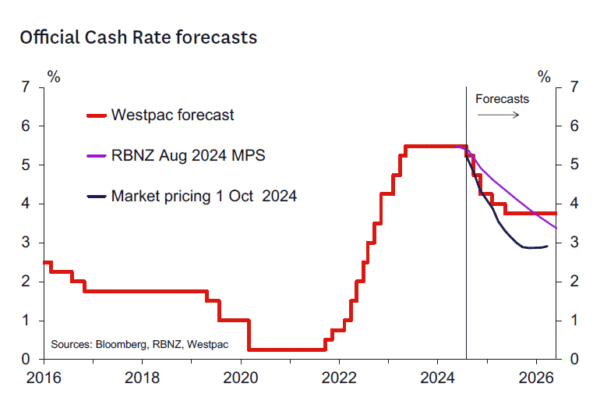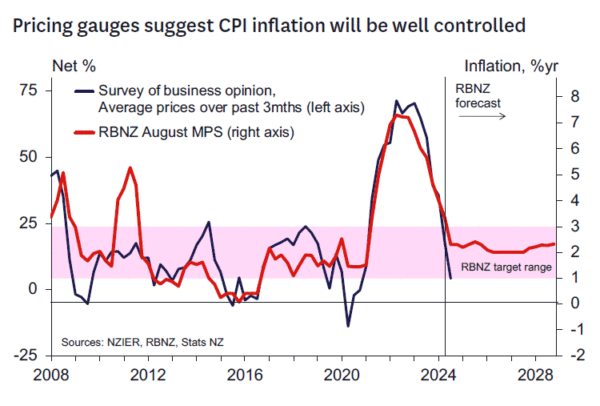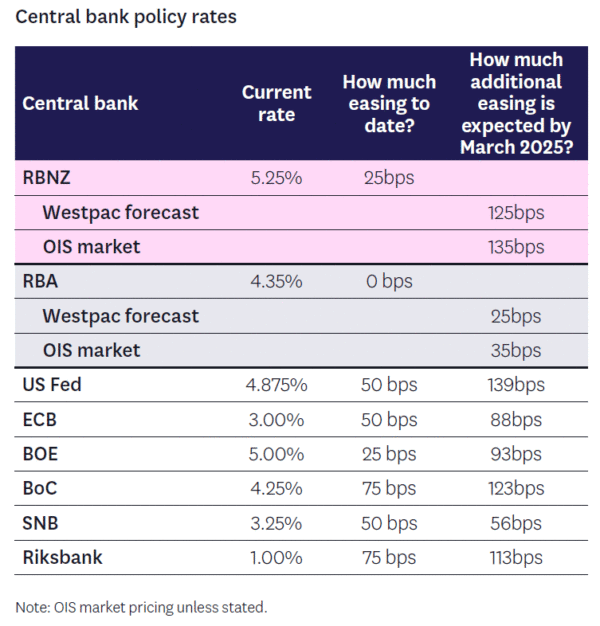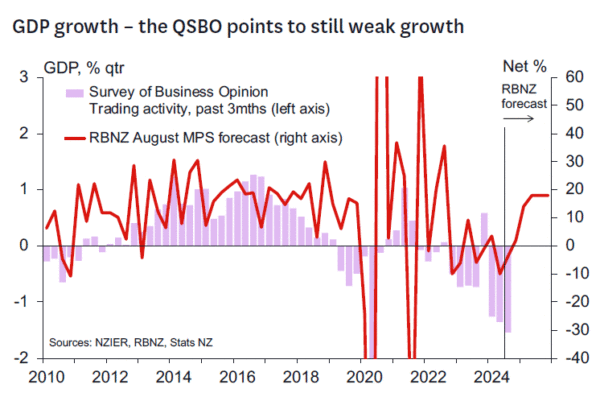- We now expect the RBNZ to cut the OCR by 50bps to 4.75% at the October Monetary Policy Review.
- We also expect another 50bps cut to 4.25% at the November Monetary Policy Statement.
- The projected step up in the pace of easing in October is a more finely balanced decision (perhaps a 60% probability) whereas the probability of a larger easing in November looks much higher.
- The inflation outlook now looks set to settle close to 2% from Q3 2024 and gives the RBNZ more room to move more quickly back to neutral settings.
- We continue to see the terminal OCR at 3.75% – the cuts expected by Christmas merely bring the OCR closer to neutral more quickly.
- We don’t see a case for expansionary settings as there are tentative signs the economy is responding to easier conditions.
- We hope the RBNZ will be more circumspect on how quickly the OCR will change in 2025 as the OCR will be closer to neutral wherever defined.
RBNZ decision and associated communication.
We are changing our forecasts for the OCR and now expect the OCR to move more quickly to neutral than previously forecast. We now see two consecutive 50bp cuts in the OCR in the October and November meetings which will take the OCR to 4.25% at the end of 2024. This will leave the OCR just 50bps above our long-term neutral rate of 3.75%. The projected step up in the pace of easing in October is a more finely balanced decision (perhaps a 60% probability) whereas the probability of a larger easing in November looks much higher.
We anticipate a much slower, highly data dependent and uncertain path lower in the OCR in 2025. We have pencilled in 25bp cuts in each of the February and May Monetary Policy Statements taking the OCR to the longterm terminal rate of 3.75% by mid-2025.
A key driver behind this change in view has been the strong signs that the forward inflation profile will be much more benign in aggregate that we have seen since 2021. Our current forecast for annual inflation in Q3 is for an annual rate of 2.4% falling to 2.2% in Q4 this year. There may be some downside risks to those short-term forecasts. Yesterday’s QSBO confirmed a benign picture for short term pricing pressures and leaves us thinking that the RBNZ will not see either headline inflation or inflation expectations pressures as an impediment to bringing the OCR to neutral levels relatively quickly.
Another issue is that the global interest rate cycle has decisively turned in recent months. Central banks have been responding to a global inflation shock and have generally responded in similar ways. We now find the RBNZ fitting well into the group of advanced economy central banks who have already eased significantly, and look set to ease by a deal more by the end of Q1 2025. The RBNZ will need to reduce the degree of restriction relatively quickly to keep pace with its peers. And now with inflation projected to be close to target, and the economy operating a fair margin below its productive capacity, there is a less obvious case for maintaining restrictive settings.
As suggested in our recent Hawks and Doves note, reasonable arguments can be made for both maintaining a 25bp point pace of easing and accelerating the pace to more quickly return policy to a neutral stance. Given the latest information, on balance we find the dovish arguments more compelling. Domestically generated non-tradable inflation remains very high, and there has already been a significant easing in financial conditions that could see the economy rebound relatively quickly and frustrate the disinflation process. However, these concerns seem less important considering yesterday’s QSBO which confirms that near-term economic momentum likely remains in negative territory. While businesses in particular are more confident of better times next year, we have some distance to travel before those become front of mind from a policy standpoint.
Housing market data similarly show increased activity, but also depressed and still falling prices, indicating the housing market recovery is most likely a 2025 as opposed to 2024 story. The stronger outlook for the primary sector is another factor that seems likely to lend significant support to the economy. But again, this is most likely to be a consideration in 2025 given commodity prices and the terms of trade are recovering from weak levels and costs remain high in the primary sector.
In conclusion, we think the RBNZ MPC will be asking themselves “What are we waiting for?” when considering the case for maintaining the OCR at what are reasonably tight levels (even based on Westpac’s 3.75% neutral OCR, let alone the RBNZ’s 3.0% to 3.5% range of shorter run neutral OCR estimates). If the answer to that question is “not much” then the path ahead seems clear, especially given the RBNZ has a long gap between meetings from November 2024 to February 2025.
We had thought for a while that if a 50bp cut was to occur, then the November Monetary Policy Statement seemed the most compelling time given that gap in the calendar. And if the case for a 50bp cut in November is strong, then the case for that move to come in October also seems compelling. We don’t think there will be enough risk in the Q3 CPI or labour market reports coming mid October/early November to really shake the case for more substantial OCR adjustment before Christmas. If those risks materialise, then there is plenty of scope for the RBNZ to cut the OCR by less in November if need be.
The challenge now for the RBNZ will be to maintain firmer control on the market’s tendency to extrapolate OCR cutting expectations. Moving the OCR closer to neutral will help with that goal. But we also hope the RBNZ will provide a clearer set of parameters on how they would expect to operate policy in 2025. Monetary policy since 2019 has ended up being strongly procyclical – far too easy in 2019-21, necessitating very tight policy settings in 2023-24. We hope the RBNZ will avoid the temptation to cut rates too aggressively in 2025 unless well justified by the inflation and economic outlook. Making the point now that a faster removal of restriction implies less need to cut so deeply later would be a good way to try and deliver the “hawkish cut” that could stabilise output and employment without driving house prices further out of reach of the public.
Developments since the August MPS.
We think the following have been the key developments since the August MPS:
- Activity: GDP fell 0.2% in the June quarter, slightly less than the RBNZ had expected. Top-down indicators, such as those in the QSBO, suggest that GDP likely continued to contract in the September quarter, while early indicators for the December quarter point to subdued growth and thus a continued build-up of slack in the economy.
- Inflation indicators: Partial indicators from the monthly Selected Price Indexes for July and August suggest that Q3 CPI inflation is likely to print close to the RBNZ’s August MPS forecast of 2.3%y/y. However, survey indicators from the QSBO suggest some potential downside risk to our forecast.
- Labour market: While measures of filled jobs have stabilised in recent weeks, indicators continue to suggest that unemployment rate likely lifted in the September quarter, broadly in line with the RBNZ’s expectations. Surveys suggest that looser labour market conditions are placing downward pressure on labour cost inflation.
- Sentiment: Headline measures of business sentiment and expectations regarding activity a year ahead have improved sharply, especially those in the ANZ Business Outlook Survey. However, the improvement seen in survey measures of consumer confidence remains modest.
- Housing: House prices appear to have contracted further in the September quarter, and probably by more than the RBNZ had expected. Indicators and anecdotes point to some lift in activity of late, but house prices seem likely to remain subdued in the near-term given the overhang of inventory on the market.
- Commodity prices: There has been some further improvement in key commodity prices, notably in the dairy sector where Fonterra has recently raised its midpoint forecast for this season’s milk price to $9.00.
- Global growth: The most significant trading partner development has been in China, where continued weak data has recently prompted policymakers to announce a slew of stimulus measures. It’s uncertain whether the RBNZ will regard these measures as sufficient to allay concerns about a potential deflationary impulse from that economy.
- Financial conditions: Domestic wholesale interest rates have continued to move lower, in part reflecting the Fed’s 50bp policy easing last month. However, with the US dollar weakening, the NZ dollar TWI is trading more than 3% above the RBNZ’s assumption for the current quarter and beyond – if sustained, this will cause the RBNZ to revise down its near-term inflation forecasts.








![Week ahead – ECB set to cut, BoC might pause as Trump U-turns on tariffs [Video]](https://www.actionforex.com/wp-content/uploads/2018/04/f-ecb29-218x150.jpg)









